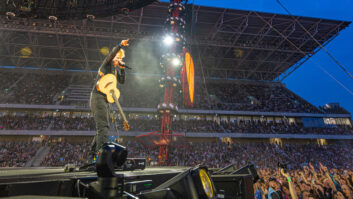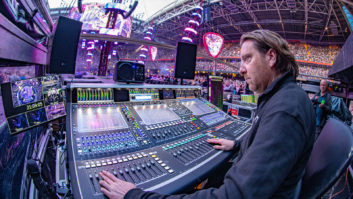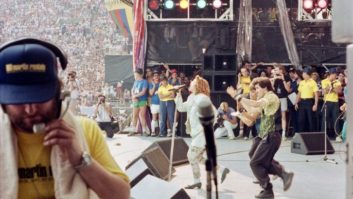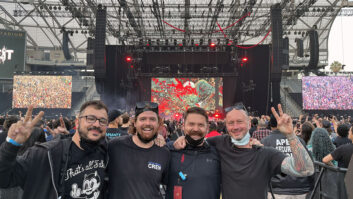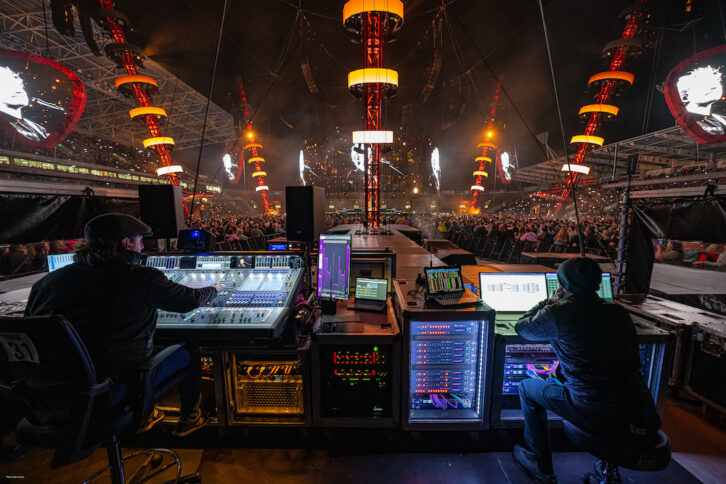
The last Ed Sheeran tour played to 8.9 million people, and he’s well on his way to breaking that world record with an in-the-round setup that has to be seen—and heard—to be believed. Part 1 explored the house and monitor mixing situation, and Part 2 dives into the massive risks—and payoff—that went into creating the tour’s innovative audio system.
NOT-SO-SIMPLE MATHEMATICS
On many tours, the stage design comes first and the P.A. is nearly an afterthought, putting the audio team in the position of having to find space for the loudspeaker hangs. On the current Ed Sheeran tour, however, the P.A. is actually a crucial element of the design, and not merely so that the audience can hear the show.
“For the design concept, Ed had always wanted to do a stadium in-the-round show, and the whole production is designed around having next to no limited sight lines at all,” said Adam Wells, audio system engineer. “Everything is about being able to see Ed from every seat of the house, and every part of the design hinted toward that, even to the fact that the P.A. is very high so that there’s no sight line issues. From a P.A. perspective, this also helps us get the top boxes of the arrays closer to ear level at the back row, requiring less array up-tilt.”
In order to provide those unobstructed sight lines, the video screens, lights and more are hung well above the crowd, and keeping all those production elements in the air is a counterbalance: the PA system. The relationship between video, lighting and sound is a literal balancing act.
“Everything in the show design is weight-calculated,” said Wells. “The loudspeaker count is identical every day and acts as a ballast for other show elements, and for that reason, every box has to go in every day—which makes my job a lot easier in terms of logistics.”
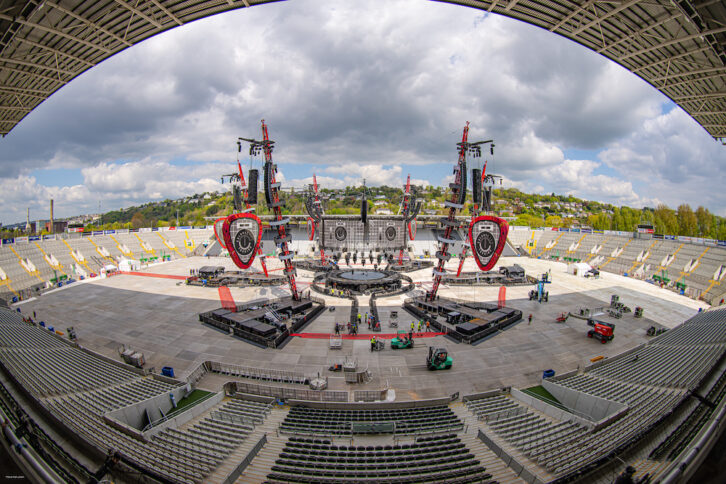
Amazingly, the crucial need to achieve that balance led to the creation of Meyer Sound’s flagship Panther line array system.
For years, Sheeran’s sound provider has been UK-based Major Tom, which fielded a sizable Meyer Sound Leo system for the 2017-2019 Divide tour. When the Mathematics tour was being devised, however, it became quickly became apparent that using Leos again was out of the question.
“A Leo is 120 kilos, and a speaker that large and heavy logistically would never have worked,” said Wells. “That prompted the conversation between Major Tom and Meyer Sound that we needed a loudspeaker with Leo SPL and Leo power, but with Lyon weight or lighter—and that’s exactly what we ended up with. It was an incredible feat of engineering on Meyer Sound’s part to be able to develop a speaker with that SPL with the footprint it has, and its power-to-weight ratio is like nothing else. It can be a theater box, an arena box and it’s definitely a stadium box—we can attest to that. I’m finding that 105 meters away, we’re still very much in the coverage zone; the speaker looks very small in the distance for what the clarity is.”
The resulting P.A. on the tour is made up of 212 Panther loudspeakers across 14 hangs configured into two rings. The inner ring comprises a half-dozen arrays that each have 10 Panther L boxes—80-degree long-throw horns—and two Panther Ms, which have a medium-throw, 95-degree horn.
Meanwhile, the outer ring has eight hangs of 16 boxes, comprising mostly Panther Ls and Ms, with the short-throw hangs getting additional Panther W 110-degree wide-dispersion horns. All of the Panthers are connected via a massive Milan AVB network, and speaker management is handled by Meyer Sound’s newly launched Nebra software.
Wells explained, “The entire audio network is managed and monitored by Nebra, and it will soon be a one-stop shop to configure, implement and monitor any Meyer system. It is a public release that, for us, has replaced the legacy RMS monitoring in Compass. We’re also helping the development team field-test new release features from an end-user perspective. We’ve got a production with over 300 loudspeakers connected to the network; that’s not something anybody else in the world has right now, so it’s a great opportunity for both parties.”
STADIUM SOUND STRATEGY
Even if the staging and P.A. hangs don’t change from day to day, the stadiums do—which presents its own set of challenges when it comes to ensuring every seat is covered. The down-tilt angles on the inner hangs are always the same, but conversely, the outer ring changes every time. Throughout the first leg of the world tour, nearly 80 percent of the shows were outdoors, but with the current North American leg, it’s been a 50/50 split of open and enclosed venues, all but one of which are NFL stadiums. That leads to floors being a consistent 360 feet long by 160 feet wide, but the height of the stands is another story.
“In these big U.S. stadiums, the vertical coverage we have to cover from top to bottom is large, so I have to get creative,” said Wells, “We’re trying to get as much trim height as we can out of these motors; the up-tilt ranges from 14 to 19, sometimes 20 degrees if I can get it, but it is right on the limit of what the center of gravity will allow us to do within the line-array design and weight distribution on motors. I’m finding that this is a balancing point now where we need to get the appropriate up-tilt on the arrays. The design is extremely smooth top to bottom. If you could take the inner ring of P.A. and slide it underneath the corresponding outer hang, you’d almost have a continuous line array; the whole thing is designed on having almost seamless transition through the entire two arrays.”
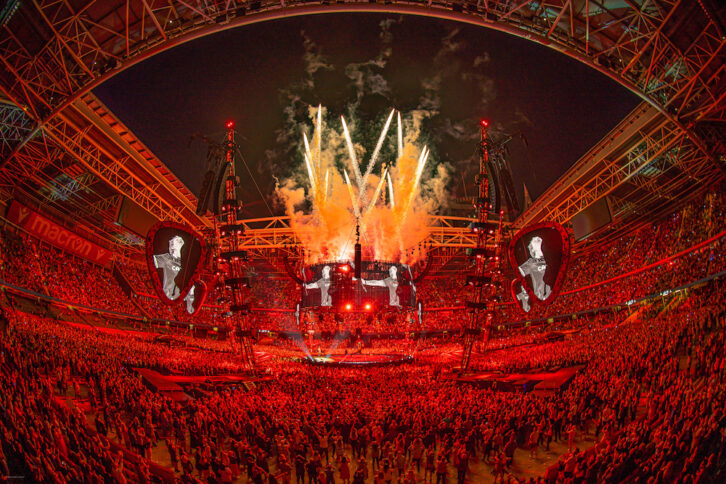
While the resulting staging feels—and is—massive, it can still get swallowed up by the sheer scale of some U.S. stadiums, said Wells: “At AT&T Stadium in Dallas, the enormous scoreboard—one of the biggest in any sporting stadium—made us look very small, but we still didn’t lose that intimacy of the show. What amazes me when I walk around during a concert is that the design is such an aesthetically beautiful thing; it still feels very intimate, and Panther only adds to that, because you still have HF clarity and what feels like a very localized source even when you’re very far away from the array.”
Mounting a production on the scale of Sheeran’s stadium tour is never a simple task, but in the late-pandemic months leading up to the tour’s April 2022 start, there were some interesting moments at Major Tom regarding being able to deliver the project while dealing with manufacturers’ delivery times and an industry returning from lockdown. Meyer Sound hit its delivery date for the massive 212-box Panther order, prioritizing it over everything else—including assembling a demo rig of its new flagship loudspeaker. As a result, said Wells, “Nobody had used it in a line array, and we were doing a show on it! It was always going to be a great-sounding loudspeaker, but we just didn’t know how good until we put it into a venue and listened to it. It was a huge leap of faith for both parties, but without question, one that paid off.”
It’s also paid off for the 4,000,000 (and counting) fans who came out to see Ed Sheeran, enjoying the close sound amidst the loose vibe and utter spectacle. While the U.S. tour leg may end at Inglewood, Calif.’s SoFi Stadium on September 23, the Mathematics tour will cast a long shadow over concert design and sound for some time to come—or at least until his next excursion.
